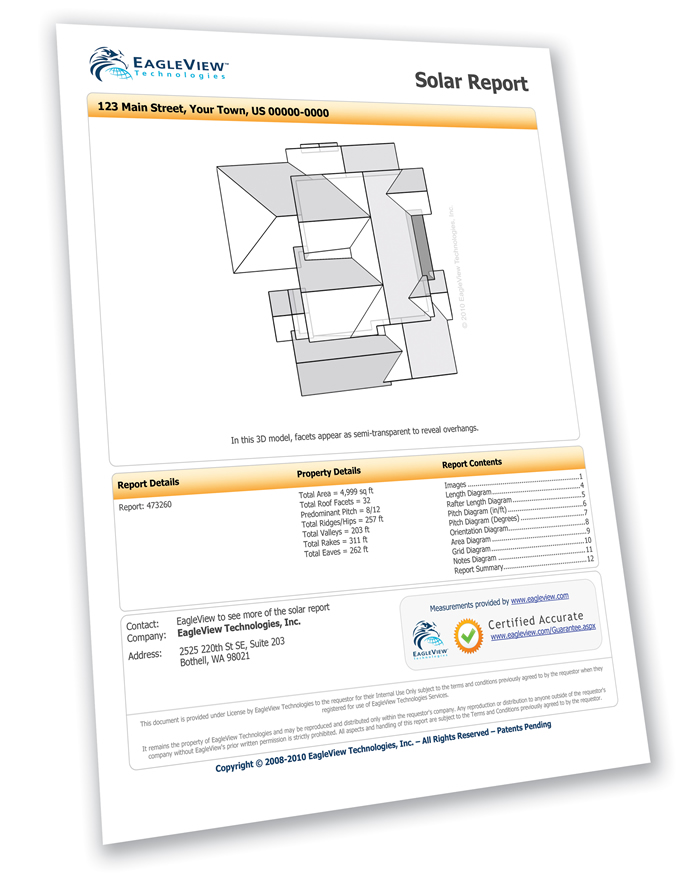Many roofing contractors see the importance that solar will play in their future business but realize they don't necessarily have the expertise required to offer solar. With new construction starts and completions remaining down, it's more important than ever for the traditional roofing contractor to be able to provide solar solutions to their customers who may be inquiring about a new roof.
Contractors utilize new technologies to provide Solar Installations
Karen L. Edwards | Eagleview
Ten years and 10 million solar systems in American homes and businesses, is it possible? The Senate Energy committee believes it is since they approved a bill by Sen. Bernie Sanders (I-Vt.) July 21, 2010 to encourage the installation of 10 million solar installations on American homes in 10 years. (Reference: http://sanders.senate.gov/newsroom/news/?id=c3fb3098-6d0c-4190-ac0c-78b162a57f65 )
For those in the roofing and solar industry this is great news and a major challenge. Many believe that more than ever they need to use every tool and technology available to meet the upcoming alternative energy demand.
For homeowners and building owners who are responding to the lure of solar grants and tax incentives it can be somewhat confusing; they are faced with the question of where to start the solar process. Solar companies touting turnkey solutions are emerging every day. It’s critical that the solar installer have a solid understanding of the roofing system that is on a building as it must protect the structure underneath for the life of the solar system. Because of the strong tie between a roof and a solar installation, more traditional roofing contractors are expanding their services and knowledge of the solar industry to become solar and roofing installers.
Roofing Contractors Offering Solar Solutions
Tecta America Zero Company, a Cincinnati-based roofing company, has been installing roofing for the commercial, residential and industrial markets since 1929. With the increasing interest in solar installations, Zero Company understood the importance of being able to provide solar installations to its customers. Gabe Drake, general manager for Zero Company, said “We are a forward-thinking company and recognized that energy efficiency and alternative energy solutions are growing increasingly more popular, especially with the funding and incentives offered by the government and utility companies. Even in Cincinnati we are amazed at the groundswell of interest from homeowners even before incentives enter the equation.”
Drake discovered a solar 3D roof measurement report recently developed by EagleView Technologies, a Seattle-based software company. EagleView has become well known in the roofing and insurance industries for providing precise, guaranteed 3D roof measurement reports. The addition of the solar report means the contractor receives everything needed to calculate solar exposure, roof square footage and panel placement.
“What these reports have done for us, with just a 10-minute investment of time, is allow us to determine if solar is even an option for a home or building owner,” explained Drake. “We can qualify them ahead of time and have a ready-to-present professional report, which in the end, saves us time and money.”
New Technology Supplies Expertise to Roofing Contractors
Chris Barrow, president and CEO of EagleView Technologies, said “We used our technology and feedback from solar installers to create a report offering important diagrams for grid layout, solar orientation and azimuth. The report provides the ability for solar installers to accurately calculate material needs and overall positioning of solar equipment.”

American Solar Electric (ASE), Phoenix, AZ was instrumental in helping Barrow’s company design the industry-changing solar report. Specializing in residential solar installations and designs, ASE installs solar electric systems that have everything homeowners need to generate their own electricity. This includes system design, approvals, installation, and full utility coordination. With over 2,300 Arizona homes and businesses featuring ASE work on their roofs, this company has positioned itself as a leader in the market.
“We are focused on the residential market,” stated Will Herndon,executive vice president of construction for American Solar Electric, Inc. “The demand for solar continues to grow in Arizona. We are focused on the market and we are using every means of technology to improve our process, sales and installations. We want to do our share of those 10 million homes.”
 “We see the azimuth table as one of the strongest components of this report,” said Herndon. “In fact, the azimuth page is excellent. The most important part for us is that it accounts for magnetic declination. Having the accuracy of EagleView measurements is critical to the solar information since we know that performance estimates for the next twenty years are at stake.”
“We see the azimuth table as one of the strongest components of this report,” said Herndon. “In fact, the azimuth page is excellent. The most important part for us is that it accounts for magnetic declination. Having the accuracy of EagleView measurements is critical to the solar information since we know that performance estimates for the next twenty years are at stake.”Another sounding board for the new report was CI Services. “We tested the solar reports and found them to be an incredible asset to our ability to estimate, plan and install a solar roof system,” confirmed Bill Baley, president of CI Services, Mission Viejo, CA.
CI Services specializes in commercial and residential roofing installations with a strong focus on solar and green applications. “We are committed to incorporating new technologies and strong roofing practices into our solar business. It allows us to make sure the solar installations will work for the homeowner and local building codes,” Baley stated.
Adding Solar to Portfolio is a Huge Asset
The important first step in providing solar solutions is being able to plan where a solar system can be installed on an existing roof, which contractors have found easier through the use of technology such as that provided by EagleView. In addition to this first step, contractors need to be able to size the array, pick the panels, choose the size and design of the rack, plan for monitoring and interface with utility companies.
Many roofing contractors see the importance that solar will play in their future business but realize they don’t necessarily have the expertise required to offer solar. With new construction starts and completions remaining down, it’s more important than ever for the traditional roofing contractor to be able to provide solar solutions to their customers who may be inquiring about a new roof. This can mean that the contractor must invest resources in hiring solar experts or sending existing employees to one of many solar training schools. Many contractors are looking for efficient ways to train their employees in solar, taking advantage of every resource and new technology that will provide them with the expertise they need in the most cost-efficient manner.
Burns and Scalo Roofing, established in 1956 and headquartered in Pittsburgh, PA, recently started Scalo Solar Solutions, LLC to provide solar installations on commercial buildings. “We found that there aren’t a lot of training opportunities for contractors who want to break into solar, “explained Tom Peters, executive vice president at Scalo Solar Solutions. “We went to a lot of classes, performed our own studies and spent a lot of time picking the brains of experts at the major manufacturers and suppliers in the United States.” Peters’ company has gone so far as to install several different systems on their own building, not only to learn from it but to offer a demonstration area for potential customers.
Training Opportunities for Contractors
The Solar industry is growing at a rapid pace and it can be difficult to find reliable sources to provide training to contractors. The National Roofing Contractors’ Association (NRCA) is one organization that understands the critical role that roofing systems play in the solar market. They also understand the need to train roofing contractors and provide them the knowledge and expertise to be able to supply solar solutions to their customers. Using technology as simple as a personal computer and the Internet, roofing contractors as well as consultants, architects and engineers can participate in NRCA’s online education ‘Roofing, Energy and the Environment Series.’ Courses such as Photovoltaics and Roofing are part of the educational experience which can earn the participant a certificate and professional recognition. There is a small fee to take these courses, but doing so in an online learning environment offers benefits in time savings and travel costs.
It’s hard to find credible training programs with so many new companies appearing on the radar every day. Kirk Roller, vice-president of Carlisle Energy Services, a PA-based company providing large, turnkey commercial solar solutions, explained that there are not a lot of traditional training opportunities for contractors. “Most solar panel companies are not providing a lot of training as much of their product is dictated by the mounting structure and other details,” said Roller. In cases of unique photovoltaic systems, such as those using thin-film solar or tubes, contractors may find training through the manufacturer. “Many contractors end up getting trained by solar distributors,” said Roller.
For Tecta America Zero Company, Drake says that training is a dilemma every day. “We are fortunate because Tecta America started a solar division recently and we are able to draw from their expertise,” said Drake. Drake has found that many solar manufacturers and turnkey suppliers are turning to his company for assistance in the installation. “These companies know solar, but don’t always understand how to properly install it on a roof without causing damage or voiding a roof warranty.”
Internet Provides Information, Training and Answers
The Internet provides an enormous amount of resources to contractors or other professionals searching for solar solutions. Online training courses, manufacturers’ and suppliers’ websites are a key source for education and information. Another convenient resource is found online at www.solarhub.com. According to their site, Solar Hub “provides a free reference database of product specification data used by professionals in the solar energy market. “ Visitors can browse the listings or search for information on PV modules, inverters and manufacturers. The site is a good starting point that leads information seekers to the companies that can provide details, specifications and possibly even training on their products and services.
Before joining Scalo Solar Solutions, Peters worked as a consultant and says he has used online tools and software such as PVwatts and PVsyst for calculations and determining monthly electricity output. “While the tools are great to have, it still requires a lot of knowledge prior to being able to plug in your numbers,” said Peters.
Drake said his company has an objective to be a solution provider and not just a roofing company. “We appreciate the value of third-party tools because they enable us to be able to speak intelligently to homeowners, architects and building owners about the feasibility of their project.”
State Incentives Scattered Throughout the U.S.
While training opportunities are still being developed and discovered, another challenge for contractors is to understand the myriad of incentives, credits and rebates that are available to the homeowner or building owner who chooses to install a solar system. This is another area where the Internet and technology can save the contractor much time and money.
In the United States, many solar incentives are state specific thus being difficult to identify. States are offering new programs all the time and with new administrations ready to step in to many states’ governments it can be a challenge keeping up with the latest rebates and financial incentives. The most recent hot spots have been New Jersey and California with many states planning to following suit.
For contractors and installers who want to know what is happening in the United States, the U.S. Department of Energy has put together the Database of State Incentives for Renewables and Incentives (DSIRE). DSIRE provides comprehensive information on state, local, utility and federal incentives and policies that promote solar energy. The database can be found online at www.dsireusa.org/solar/.
Relying on Third-Party Solutions Becoming a Necessity
With solar experts emerging on a daily basis, it is more important than ever for contractors to rely on information provided by a reliable, respected, trustworthy source. Again the best place to start is with the U.S. Department of Energy. Their Solar Energy Technologies Program was developed to achieve high market penetration of solar energy technologies (www1.eere.energy.gov/solar/). The Solar Program has several areas of focus with perhaps the Market Transformation Program being of highest interest to contractors and installers. The program’s goal is to reduce market barriers to solar power through non-R&D activities, including infrastructure development, outreach and technical assistance.
The Solar Energies Industry Association®(SEIA) reports that companies and research labs are continually discovering new techniques and materials that improve the efficiency and reduce the cost of capturing solar energy. The goal is to commercialize the most promising technologies to improve delivery of solar power generation for homes, businesses and government.
A contractor or installer must be knowledgeable about the latest developments within the solar industry yet this can take an extraordinary amount of time. There is a need to find a balance between staying knowledgeable and continuing to run a profitable business. The contractor often turns to reliable, third-party resources to stay educated and remain productive in their business at the same time.
EagleView’s Barrow explains that one of the goals behind his company’s reports is to help the contractor by providing a reliable source of accurate information related to their potential jobs. “We understand that this market is growing phenomenally every day. It’s hard enough for the contractor to keep up with the requests for solar estimates. We are providing a service that not only saves them time but provides the critical information they need to accurately assess a project’s potential solar value.”
ASE’s Herndon confirmed the value of using the third-party tool. “The combination of contractor feedback and strong software development has created a tool that is going to change the solar industry,” said Herndon. “We see this as one of the most powerful tools to come along in a long time.”
10 Million Homes A Reality?
At the rate that the U.S. solar market is growing, 10 million solar systems in American homes in 10 years may not be such a lofty goal. According to Bloomberg New Energy Finance, the United States currently generates 1.4GW of electricity from solar, enough to power about 750,000 homes.  To increase the United States’ solar production to 44GW by 2020 (enough to power more than 20 million homes) depends on the amount of financing available, which according to Bloomberg, needs to be about $100 million. This growth should be possible through the decreasing cost of equipment and the strong support being shown by the government.
To increase the United States’ solar production to 44GW by 2020 (enough to power more than 20 million homes) depends on the amount of financing available, which according to Bloomberg, needs to be about $100 million. This growth should be possible through the decreasing cost of equipment and the strong support being shown by the government.
 To increase the United States’ solar production to 44GW by 2020 (enough to power more than 20 million homes) depends on the amount of financing available, which according to Bloomberg, needs to be about $100 million. This growth should be possible through the decreasing cost of equipment and the strong support being shown by the government.
To increase the United States’ solar production to 44GW by 2020 (enough to power more than 20 million homes) depends on the amount of financing available, which according to Bloomberg, needs to be about $100 million. This growth should be possible through the decreasing cost of equipment and the strong support being shown by the government. Whether or not the actual number of homes sporting solar in 10 years actually reaches 10 million, there is no doubt that the solar industry will see explosive growth over the next decade. This also means that there is also no doubt that roofing and other general contractors are sure to profit from this growth.
Karen L. Edwards
Edwards is a freelance writer for the construction and roofing industries, with a background in marketing for several major roofing manufacturers and solar solution providers.
The content & opinions in this article are the author’s and do not necessarily represent the views of AltEnergyMag
Comments (1)
This article is dumb. one person could build a windmill to power the lights in his family home and while he is using more energy than he is producing from the food he eats it is not as though someone else is having to produce it for him. so this one person is easily producing significantly more energy than his .1 hp you suggest, and he did it with his mind. work smarter not harder. humans are not very good energy generators that is why we have used our brains instead to harness other things that are more efficient producers of energy.
Featured Product

MORNINGSTAR - GenStar MPPT
GenStar MPPT is the industry's first fully integrated solar DC charging system, an all-new design with "lithium DNA" from the leader in charge controllers. Out of the box, GenStar is an overachiever-delivering legendary Morningstar quality, efficiency, power and reliability along with the latest in advanced communications and control technologies. All the most installer-requested features are on-board; additional features can be easily added via Morningstar's ReadyBlock expansion technology, with snap-in blocks that provide battery metering and monitoring, signaling and load control, and lithium battery communications/control
